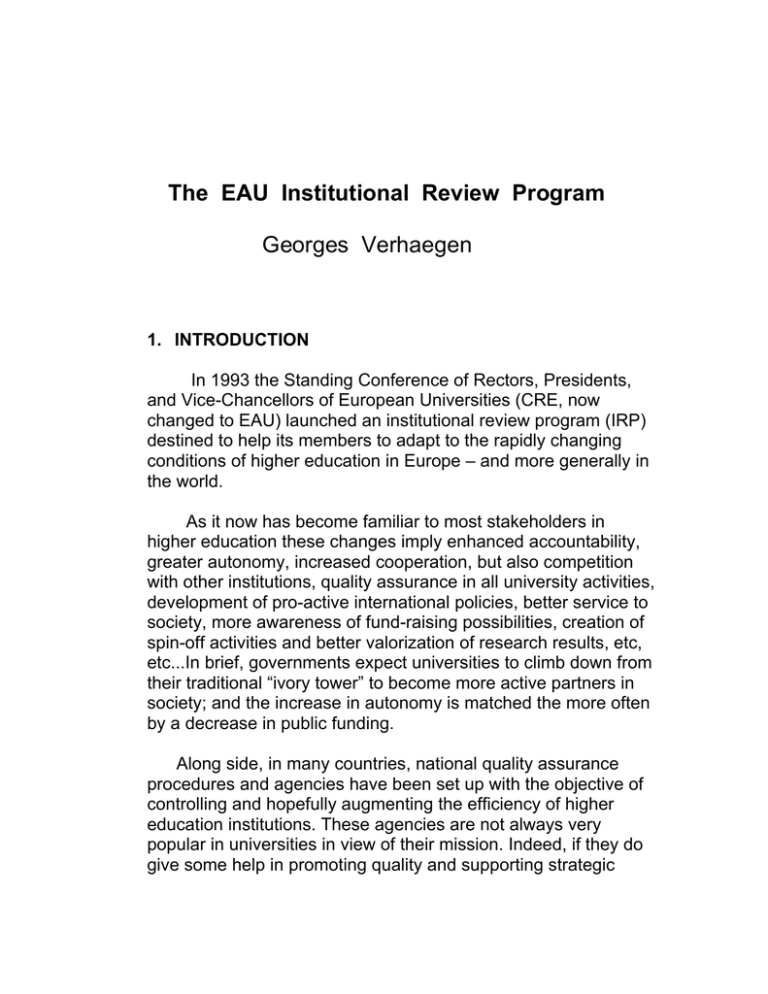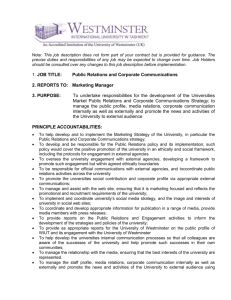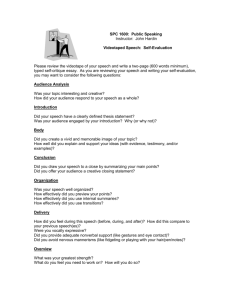The EAU Institutional Review Program
advertisement

The EAU Institutional Review Program Georges Verhaegen 1. INTRODUCTION In 1993 the Standing Conference of Rectors, Presidents, and Vice-Chancellors of European Universities (CRE, now changed to EAU) launched an institutional review program (IRP) destined to help its members to adapt to the rapidly changing conditions of higher education in Europe – and more generally in the world. As it now has become familiar to most stakeholders in higher education these changes imply enhanced accountability, greater autonomy, increased cooperation, but also competition with other institutions, quality assurance in all university activities, development of pro-active international policies, better service to society, more awareness of fund-raising possibilities, creation of spin-off activities and better valorization of research results, etc, etc...In brief, governments expect universities to climb down from their traditional “ivory tower” to become more active partners in society; and the increase in autonomy is matched the more often by a decrease in public funding. Along side, in many countries, national quality assurance procedures and agencies have been set up with the objective of controlling and hopefully augmenting the efficiency of higher education institutions. These agencies are not always very popular in universities in view of their mission. Indeed, if they do give some help in promoting quality and supporting strategic change, they also control the general quality of the institution with eventual backlashes in funding. The IRP, which began before most of the national quality assurance procedures were in place, stems from a somewhat different philosophy. Since it was created as a service to the member universities of the association, it is totally supportive of the institution volunteering to be evaluated. Further, it has an international character as the evaluators all proceed from different national contexts, which gives the resulting review a much broader perspective. Also, since the review is conducted by peers (acting or former rectors from European universities), and that no resulting sanctions may be pending, contacts between the evaluated university and its evaluators tend to be more open and frank, also to the benefit of the quality of the review. Since IRP is dedicated to strengthen universities, and in accord is designed to help them improve their strategic capacity, no attempt is made to qualify the academic or research level of the institution being evaluated. Rather, the emphasis is placed on the capability of the university as a whole to develop a strategic capacity enabling it to define and implement its priorities. Although the basic idea is simple, its application may be quite difficult because, as we know, leading a reform in a university is no easy matter due to the intrinsic nature of this type of institution: different faculties may have different interests, and thus different priorities; some fields are more expensive than others, and sharing resources is not always a widely distributed quality in universities; and finally, most professors tend to be extremely conservative when it comes to changing their outlook on university matters. As a result, the role of the rector is primordial in managing any change in policy of his/her institution, and, since his/her status is often limited to that of primus inter pares it takes a lot of effective leadership and convincing to achieve any sort of reform. Therefore, it is not surprising that many rectors welcome outside support and counsel. Their motivation mat be manyfold: sometimes they realize that some reforms are necessary, but they have difficulties in setting priorities; sometimes they need help in implementing reforms; sometimes (often), they desire to confront their ideas with external expertise. These reasons probably explain why the program has had a wide success; so far 82 universities from 30 different countries, including institutions in South America and South Africa, have participated to IRP, and a sizable fraction of these enlist for an additional appraisal a couple of years later to ensure themselves that they are proceeding in the right direction. 2. THE PROGRAM IRP is constituted by four (five) distinct phases: • a self-evaluation report; • a first exploratory site visit by the review team; • a main evaluative visit; • a review report; • an optional follow-up visit 2-3 years later. We shall now briefly describe each point. a) The self-evaluation report The first step in the process is a self-assessment by the university. The Rector appoints a self-evaluation team to draw up a report on the institution which should be descriptive, analytical...and critical. This is a very crucial document and it is often considered to be the most important component of the whole process; therefore the university is urged to attend to it with due care. Ideally this ~30 page (plus annexes) document should give the review team a clear picture of the institution, its aims, its achievements, its decision procedures and practices, its planning capacity, as well as its shortcomings. In short, it should try to answer the basic questions: • What is the university trying to achieve? • How is it doing it? • How does it know it has worked? • How can the university change to improve? If these questions are simple, the answers often prove to be difficult, because, for many institutions, it is the first time that they are confronted by a critical examination of their structures and decision-making processes. If the university wants to make the most of its evaluation, it is important that the self-evaluation report reflects the opinions of the main share-holders of the institution. However good is the report, if it is written by the Rector and his/her staff only, it will not be shared by the university community as a whole, and as a result, the effort will be largely wasted. Therefore it is important that the self-evaluation steering committee be composed carefully and include different actors in the institution (directors, deans, staff, students). It is also good practice to circulate the report inside the university prior to the visits of the review team. Finally, if the university has already some sort of quality culture imbedded in its management, it proves most useful to include a so-called SWOT (Strengths, Weaknesses, Opportunities, Threats) analysis in its self-evaluation report. b) The First Visit After reading the self-evaluation report, the review team, composed of three rectors or former rectors and a team secretary proceed with a two-day visit of the university. The aim of this visit is to gain a better insight of the institution, understand the local context and national regulations, and very often acquire additional information not included in the self-evaluation report. In essence, it serves the purpose of fully clarifying the report. c) The Evaluation Visit Once all information is gathered, the team comes back for a three-day visit with the object of evaluating the institution. The procedure is for the review team to meet separately as many stake-holders as possible, cross-check the relevance of the selfevaluation report, pin-point any specific problems the university might have, and try to formulate adequate advice for solving them. Often, it is the Rector himself who suggests what the main difficulties of his/her institution are, but sometimes it is the review team who discovers major problems the university seems to be unaware of. On the last day of the visit, the team, usually the chairman, delivers an oral report on its findings and suggests solutions to the problems encountered. Although the audience to this report is selected by the rector and may vary, most often many of the interviewed people are present, and sometimes many more. The oral report is usually followed by a wide discussion with the audience. d) The Review Report Two to three months later a full written report (~25 pages) is produced by the secretary of the team in collaboration with the other members of the team, especially the chairman. In this report all the points brought up in the oral report are taken up again in greater detail. The report is then sent to the rector to eventually correct any factual errors, and then it becomes final and sent to the EUA headquarters. The reviewed university is strongly advised to publish the report, or at least to circulate it widely intra muros. The reason for this is to encourage the rector to share the evaluation experience with all the university actors in order to promote as much as possible the culture of change and improvement in his/her institution. e) The Follow-up Visit After roughly two years the reviewed university sometimes wants another visit from IRP to check on some of the changes that it has accomplished, or more generally to discuss new problems. The follow-up visit is preceded by a report of the university stating how it has evolved, what problems it has met, and precisely what is expected from the follow-up visit. This visit is a one-shot two-day visit by a team of one rector and one secretary, and is followed by short report only since the institution is already well-known to IRP. Interestingly, what is quite often experienced, is that the university has indeed changed, not always on all the specific points suggested by the first review team, but on other points as well. This shows that the IRP proves to be a good catalyst for bringing about improvement through change in some of the universities it visits. 3) CONCLUSIONS In the changing university context, EAU has brought a novel (supportive and international) approach to the difficult problem of evaluation. The IRP process, although it covers only the management of the university, has proved to be a powerful vector for improving the general quality of most institutions which have volunteered for the program. Indeed, maybe more important than the specific advice given by the review team, the university has been obliged to proceed to a critical examination of its functioning, and, most often, it is the first time it has done so. In many cases this sparks off quality assurance mechanisms for the future, and that is exactly the main objective of IRP.



